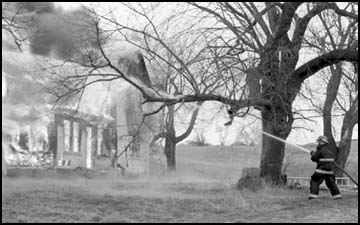 More than two years of training for the Paynesville Fire Department culminated with a live burn Saturday morning.
More than two years of training for the Paynesville Fire Department culminated with a live burn Saturday morning.Dr. Randy and Molly Zimmerman donated an old house on their Cedardale Road property, southeast of Paynesville, to the fire department more than two years ago.
Since then, the fire department has used it at least 15 times for training exercises, according to Jeff Ruprecht, training coordinator for the fire department. Sessions included search and rescue missions in smoke and salvage operations.
"You can't get better training than this," said Ruprecht.
A live burn allows fire fighters to watch and feel the fire themselves. "It does so many things," Ruprecht said of fire. "It creates its own heat. It creates its own wind."
Although there is a considerable amount of paperwork, allowing the fire department to use an old house for training counts as a donation to the department. "If we didn't have these types of houses to burn down, if they just plowed them under, we'd lose a lot of training value," Ruprecht added.
Because there is also a lot of paper work in doing a live burn, the local fire department contracts with St. Cloud Technical College to do the burn. The live burn also served as the final exam for 10 local fire fighters who took the Fire Fighting I course through the college. Graduates of the course belong to the Lake Henry, Paynesville, Richmond, and St. Martin fire departments.
The fire fighting class meets two hours a night, two nights a week, for two months. In all, the class requires 80 hours of training, according to Pat Evens, fire program manager at St. Cloud Technical College.
The graduates got their first feel of real fire with the live burn. Using the different rooms of the house, seven controlled burns were done separately.
In the room with the fire, the volunteers felt the heat and saw the smoke. Evens said the training is crucial for fire fighters to learn about the claustrophobic feeling of being in a confined space with a fire.
One key lesson involves thermolayering. As the fire spreads up the walls to the ceiling, the gases at the top of the room become heated, 10 ten times hotter than normal fire, according to Evens. These superheated gases, he said, can cause the explosions depicted in the movie Backdraft.
The fire fighters hit the ceiling with a burst of water, which vaporizes and continues to combat the fire. They also learned about hydraulic ventilation, breaking a window to the outside with water spray and by hand, to let the superheated gases escape.
"It surprised a lot of the beginners with what it's like in there," said Evens. "That's why you can only do so much simulation."
After the controlled burns were done, the fire fighters allowed the house to burn down. Water was applied to the walls and to the chimney to cool the outside and allow the inside to burn first, collapsing the house on its foundation. Evens said the ash and foundation will be hauled to a certified landfill.
With the high near 50 degrees Saturday, the weather for the burn was ideal. The burn was originally planned for last fall, but a lack of precipitation prevented it. The fire department waited for two inches of snow and then mild temperatures. The rain on Friday provided enough moisture to contain the fire.